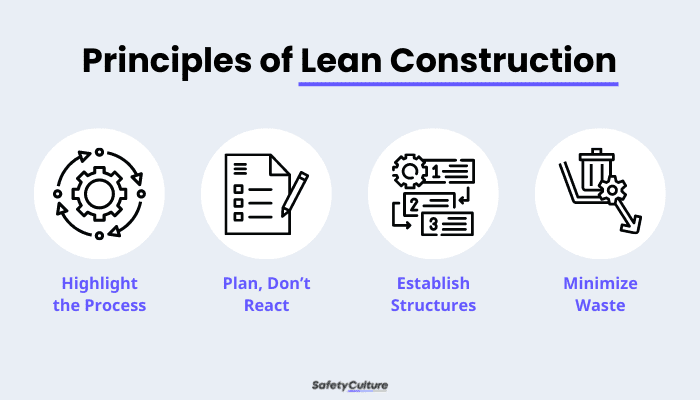What is Lean Construction?
Lean construction is based on the principle of increasing value and minimizing waste. It revolves around the concept of construction which employs various measures to reduce wasted time, effort, and resources while producing higher-quality outputs. The main objective of lean construction is to eliminate or at least minimize waste at every opportunity.
The construction industry typically operates under a “more is more” philosophy, but Lean construction turns that concept on its head. This philosophy takes a lot from Lean manufacturing.
However, manufacturing takes place in a controlled environment, while construction doesn’t. So, managers need to consider more factors when implementing Lean construction within a construction site or organization.
Lean Construction Principles
The entire concept of lean construction is based on the principle of minimizing waste. This includes wasted materials, efforts, and time, all with the goal of producing higher-quality outputs more efficiently.
However, there are other principles upon which Lean construction is based, including:

Principles of Lean Construction
Highlight the Process
In traditional construction projects, the emphasis is on contracts and transactions. This creates a transactional work environment where everyone is only focused on themselves. When employing lean construction, organizations highlight the processes instead of transactions.
When the teams focus on the process, it invites more collaboration and efficiency. For example, the subcontractor works with the entire team when determining the design, forwarding the design to the general contractor, who then determines if the design is ideal for the project.
In Lean construction, the process is always done in relation to the final product. So, instead of performing processes just because it’s supposed to be done that way, one of the principles of lean construction involves performing processes with a definite end goal in mind.
Plan, Don’t React
In Lean construction projects, the team always builds strategies with the end goal in mind. Instead of reacting and looking at things in the short term, lean construction emphasizes long-term productivity and efficiency.
Establish Structures to Achieve Goals
Lean construction is a systematic approach. In these types of projects, employees work together based on different structures that were put in place to optimize certain processes. That way, the jobs are finished faster, and the final output is top-quality.
Minimize Waste
The entire goal of Lean construction is to minimize waste. In construction projects, waste can cost the organization a lot, whether wasted materials, effort, or time. All the processes involved in lean construction and its principles are done to reduce waste throughout the entire project. That way, the process is made more efficient and optimized so that the entire team achieves its ultimate goal.
Benefits
Here are some of the benefits that organizations can receive by employing Lean construction in a project:
Increased Efficiency
The primary benefit of using Lean construction for a project is increased efficiency. When done properly, Lean construction can result in lesser waste, which means that organizations spend less and that projects are completed sooner. This way, it’s much easier to stick to the schedule and deliver high-quality outputs based on well-made strategies.
Remember, lean construction is all about minimizing waste. When waste is minimized, it’s easier for everyone to accomplish tasks and finish the project.
Enhanced Safety
Another benefit of Lean construction is enhanced safety. There are many inherent risks with construction projects. And when creating a strategy with lean construction in mind, it’s important to consider all the safety risks and hazards that employees may face throughout the project.
That way, the team plans around the risk while also putting controls and measures in place to protect the workers. When you do this, there’s a lesser chance of accidents and incidents that may put your employees and the entire project at risk.
Reduced Costs
Waste can greatly cost an organization. So, another benefit of employing lean construction is that you don’t spend as much on a project. When implementing Lean construction, you spend less on materials and working hours as you aren’t wasting time and resources throughout the project’s duration.
Quicker Turnaround Time
Lastly, when employing Lean construction techniques during a project, organizations can finish the job faster. Lean construction involves establishing a proper strategy that aims to accomplish specific goals. That way, the processes are laid out clearly, and everyone on the team understands the job at hand.
Digitize the way you Work
Empower your team with SafetyCulture to perform checks, train staff, report issues, and automate tasks with our digital platform.
Get Started for FreeHow to Adopt Lean Construction
Adopting Lean construction is an organization-wide effort. To start, it involves auditing and inspecting different machinery and processes. This is meant to determine which processes can be done better, where the most waste is produced, and any issues with processes that can be corrected.
From there, the team needs to create a proper strategy and establish different processes for the team. When they do this, it gives the entire project a definite framework to follow. That way, there’s less waste, and everyone understands what they need to do to achieve the project’s goals.
Lastly, adopting lean construction involves implementing Lean principles throughout the organization. This requires rigorous and comprehensive training for everyone on the team. Doing this allows organizations to ensure everyone is on the same page and knows exactly how to accomplish the task at hand.
FAQs about Lean Construction
Lean construction traces its roots to the lean manufacturing principles used by Toyota in the 1960s. However, the Lean Construction Institute itself was created in 1997 by Glen Ballard and Greg Howell.
In Lean, waste is defined as anything that doesn’t add value to the customer or final product. This could mean any unnecessary step in the construction process, along with materials and resources that go unused.
Lean construction is ideal for organizations looking to streamline projects and make things more efficient. Employing Lean construction ideals is great for any construction project, especially when the team is looking to finish the project as efficiently and safely as possible while still achieving the overall goal.




